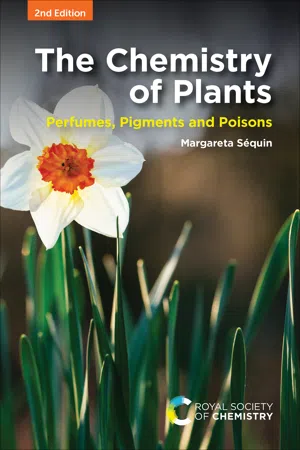
- 206 pages
- English
- ePUB (mobile friendly)
- Available on iOS & Android
About this book
Why are some plants so important to humans? The chemistry of the plants has a lot to do with it!
The plant world offers a fascinating way to explore basic chemistry concepts. The spectacular variety of colors, fragrances and other characteristics of plants are driven by the seemingly subtle differences in the structure and properties of organic compounds. Well-known flowers, like daffodils and narcissus, are examples of plants that provide ample perfumes, pigments and poisons as part of their intricate and fascinating chemistry.
This second edition retains it accessibility, expanding on the first edition and combining scientific concepts with colorful pictures and stories in simple, clear language. Readers will find introductory information on some chemistry and plant biology. This prepares them for the more complex chemical structures that compose plant substances, many of them of vital importance to humans. The final chapter has been expanded, in particular the sections on medicinal plants and on genetic modification. The end-of chapter references have been thoroughly updated with articles, books, and relevant websites that illustrate the topics discussed.
Dr Margareta Sequin, an organic chemist and plant enthusiast, has taught popular undergraduate college level courses on plant chemistry to non-chemistry majors and has led numerous field seminars for the general public. The comments and questions from these audiences and the topics that especially captured people's interest have greatly shaped this book.
The Chemistry of Plants addresses an audience with little previous chemistry knowledge, but will appeal to the expert reader looking for an understanding of more complex plant compounds. It can be used both as a text to introduce organic chemistry as it relates to plants and as a text of reference for more advanced readers.
Frequently asked questions
- Essential is ideal for learners and professionals who enjoy exploring a wide range of subjects. Access the Essential Library with 800,000+ trusted titles and best-sellers across business, personal growth, and the humanities. Includes unlimited reading time and Standard Read Aloud voice.
- Complete: Perfect for advanced learners and researchers needing full, unrestricted access. Unlock 1.4M+ books across hundreds of subjects, including academic and specialized titles. The Complete Plan also includes advanced features like Premium Read Aloud and Research Assistant.
Please note we cannot support devices running on iOS 13 and Android 7 or earlier. Learn more about using the app.
Information
1.1 Introduction

1.2 Plants and Their Elements
| Element | Some major functions | Sources |
| Macronutrients | ||
| Carbon | Essential component of organic compounds | CO2 |
| Oxygen | Major component of organic compounds | H2O, O2 |
| Hydrogen | Major component of organic compounds | H2O |
| Nitrogen | Component of nucleic acids, proteins, chlorophyll, alkaloids | NO3−, NH4+ |
| Sulfur | Component of some amino acids, proteins, coenzymes | SO42− |
| Phosphorus | Component of nucleic acids, ATP, phospholipids, coenzymes | H2PO4−, HPO42− |
| Potassium | For osmotic balance, operation of stomata; enzyme activator | K+ |
| Calcium | Required for formation and stability of membranes; activation of some enzymes | Ca2+ |
| Magnesium | Component of chlorophyll; activates many enzymes | Mg2+ |
| Micronutrients | ||
| Iron | In chlorophyll synthesis, activates some enzymes | Fe3+, Fe2+ |
| Chlorine | For ion balance; in water-splitting process of photosynthesis | Cl− |
| Boron | Cofactor in chlorophyll synthesis | H2BO3− |
| Manganese | Activates enzymes; in chlorophyll synthesis | Mn2+ |
| Copper | Involved in redox reactions | Cu2+, Cu+ |
| Zinc | Activates enzymes | Zn2+ |
| Molybdenum | Essential for nitrogen fixation | MoO42− |
| Nickel | Cofactor for enzymes in nitrogen metabolism | Ni2+ |
Box 1.1 A Brief History of the Periodic Table of Elements.
Table of contents
- Cover
- Title
- Copyright
- Preface
- Glossary
- Contents
- Chapter 1 Basic Plant Chemistry Concepts
- Chapter 2 The Molecular Building Blocks
- Chapter 3 Perfumes, Volatile Plant Scents
- Chapter 4 Colorful Plant Pigments
- Chapter 5 Poisons and Other Plant Defenses
- Chapter 6 Plants and People
- Epilogue
- Subject Index